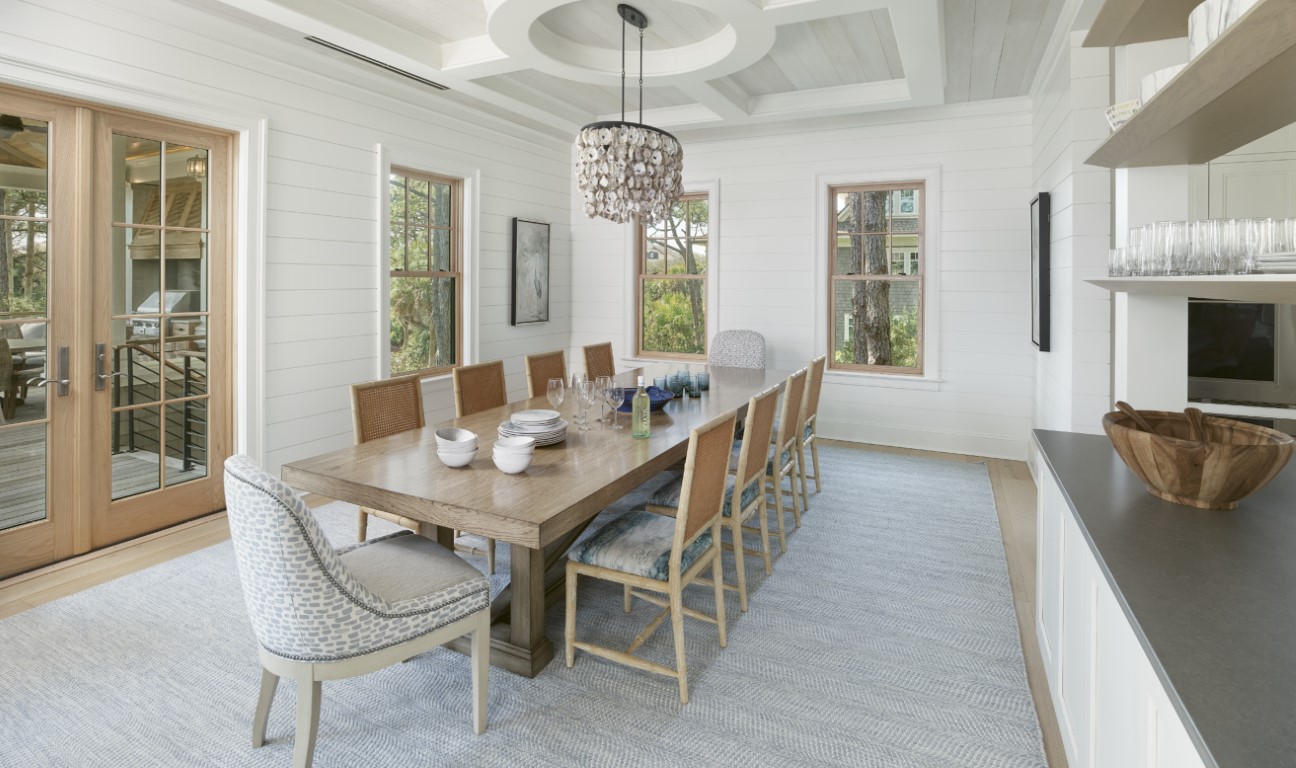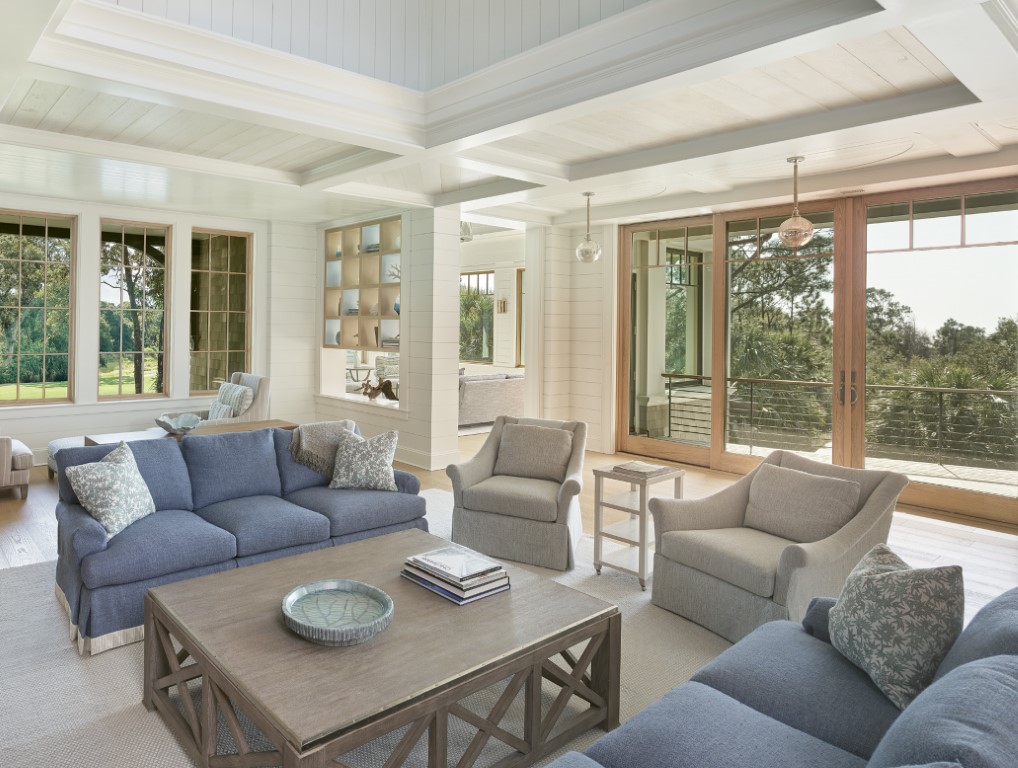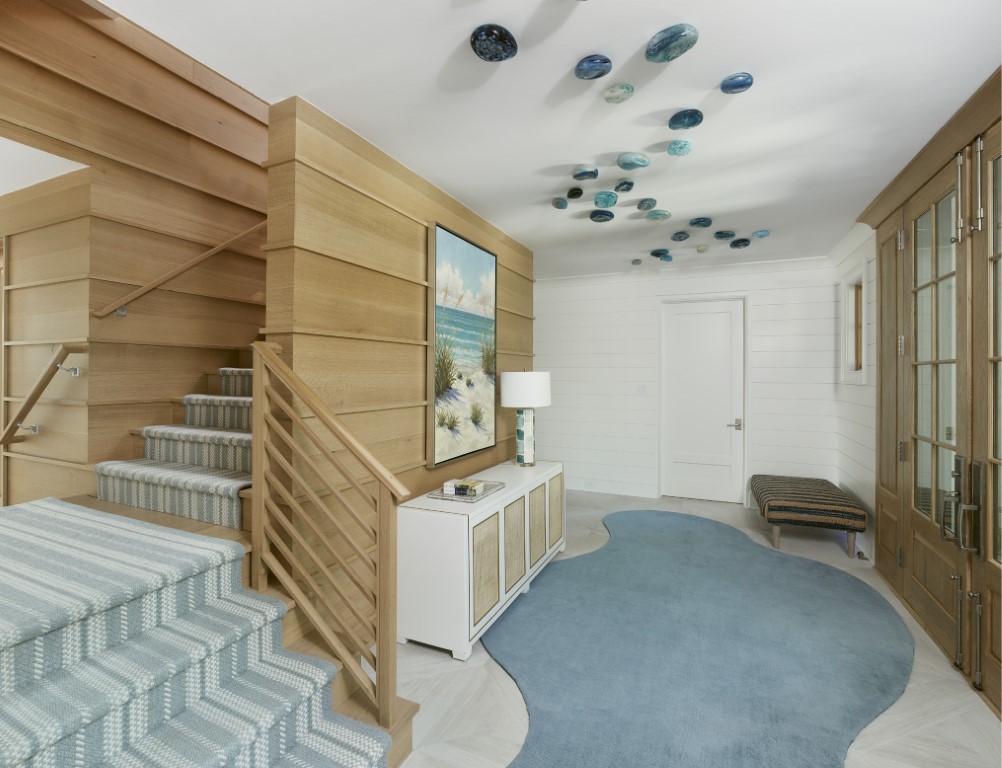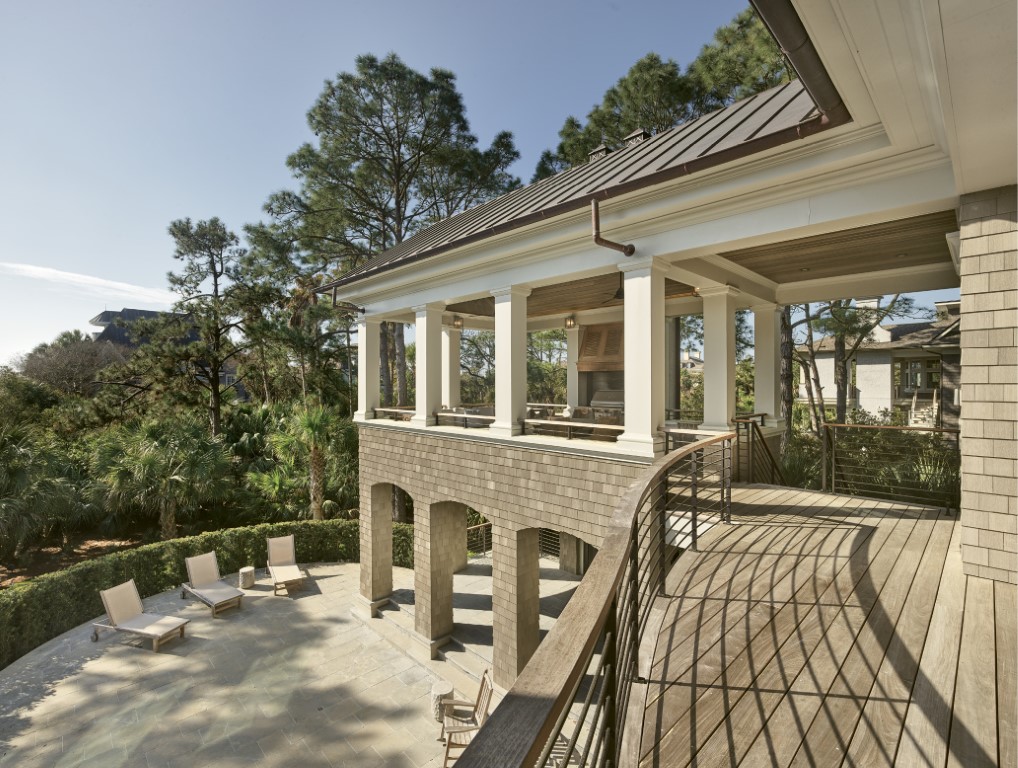
The house we’re going to see today is the third home architect Bill Huey designed for his clients on Kiawah Island. This time the clients wanted a forever home, a place that would be comfortable when it’s just the two of them but expansive to accommodate extended family. They asked Huey for an open, communal design so everyone could be together, lots of porch space for outdoor living and activities, low-maintenance interiors and exteriors, and non-fussy comfort.
The home was designed by Huey and architect Nicole Putnam (also of Bill Huey + Associates), built by Jedd McLuen of Bennett-McLuen Homes, and has interiors by Rebekah Carter and her team at Red Element Design Studio. Because the clients had worked with the architect and designer before, they gave them a lot of latitude. “The clients wanted the house to be beautiful without being precious,” Carter says. “There was a lot of trust, but this particular team shares an obsession for detail. When that’s a common goal, it pushes you much harder.”

The team worked in tandem from inception, and their passion and harmony are reflected in the results. The home is both cozy and expansive, functional and beautiful, simple and surprising, and extremely comfortable. The 7,171-square-foot house has seven bedrooms, seven and a half baths, an office, two primary living areas, two bunk rooms and four porches. It has direct ocean access via a 1,000-foot serpentine boardwalk, a shape reflected in many of the home’s subtle design details.
Because the clients wanted a low-maintenance home, exterior materials were chosen for their ability to stand up to salt spray, heat, wind, rain and all of the conditions that come with living by the ocean. “There’s virtually nothing on the exterior that needs maintenance,” McLuen says. “We used stone, PVC siding, French limestone, tabby stucco, aluminum powder-coated railings and copper details on the roof. It’s pretty bulletproof for an ocean-front home.”

Huey reversed the floor plan to take advantage of the views, putting the living areas on a higher level. As an elevated house, the ground floor is garage space; the first floor is secondary and tertiary bedrooms; the second floor has common living areas and the client’s bedroom; and the top floor is home to bunk rooms, an office and a workout space.
On the interior, Huey and Carter kept it simple. McLuen expertly executed Huey’s refined architectural details, and Carter’s choice of fixtures and furnishings complement the backdrop. “It is an island home, but I didn’t want to knock people over the head with seashells everywhere,” she says. “We’re never going to get better than nature, so we complement it as much as possible. It’s all about texture and use of color; some rooms are soothing, and some are more playful.”
As we enter the first floor, a cozy common area directs traffic up the stairs to the living space. This shiplap-clad room begins to tell the story of the home with whimsical blown glass river stones on the ceiling and a water-evoking rug. As we ascend the stairs, pay close attention: The unusually spaced horizontal board-and-batten on the wall creates a rhythm that runs through the center of the house, connecting everything. “The spacing of the board-and-batten responds to the stair treads, so every second step, there’s a batten,” Huey says. “It’s a uniform element throughout the house that connects to the staircase.” Many details in the home, including the bookshelves on the first level outside the den, respond to the battens. “It was one of the most difficult elements to pull off,” McLuen says. “It was a lot of detail with no margin for error over three floors, and I’m proud we did it on the first try.”

At the top of the stairs, the home opens to the living areas, dining room and kitchen. The first thing you’ll notice is the ceiling. In the center of the room, a four-sided stained-glass window with pivoting windows rises through the upper floor. Huey designed the 12 sea glass-colored panels, so the wavy, flowing shapes make it feel like you’re underwater.
Beneath this dramatic element is a living area with a comfortable seating group centered around a wall-mounted TV and a built-in console. Behind the sofa, two chairs and an ottoman face each other in front of the expansive windows to create a quiet conversation area. “From the conversation alcove, you can see the exterior brackets,” Huey says. “It’s nice to have cozy spaces for two that can also help the house expand for parties. I love pause spaces where you can just read or have a conversation.”

A doorway at the back of the room leads to the second living area, affectionately known as the View Room, with more comfortable seating and expansive views over the landscape to the ocean. “What I love about this room is there’s a fireplace and bookshelves, and it’s just a quiet place to read or hang out together,” Huey says. The fireplace’s vein-cut travertine slab surround set the color palette for the room, and in a nod to one of the South’s oldest traditions, the raised ceiling has a blue wash.
The open kitchen has a large cooking island that seats three at a raised bar. An intricate blue-green and white marble mosaic to the right mimics moving water. Huey designed the floating shelves to have a knife-edge, an element he carries throughout the home. Behind the kitchen, a large scullery keeps the central kitchen tidy and provides ample storage for enough supplies and snacks to feed a large group.
To the left of the kitchen, an opening flanked by Huey’s signature floating knife-edge shelving leads to a dining room that seats 10. Walls are clad in white shiplap, and an oyster shell chandelier hangs from an architecturally detailed ceiling, giving the room a comforting visual weight.

Back in the first living room, a doorway leads to the client’s bedroom and bath. “We wanted this to be a serene escape,” Huey says. “The clients said they just wanted the bedroom for sleeping, so the view wasn’t important. It was helpful to know that, so we placed the bedroom on the street side and reserved the view rooms for public spaces.” The architect, designer and builder reserved the wow factor for the client’s bath.
From the bedroom, a sophisticated galley hallway features built-in wardrobes of book-matched walnut, a seating niche for putting on shoes and socks, and high windows for privacy. The clients have their own stacked washer and dryer through the door under the sconce.
At the end of the hall is a large glass-walled curbless shower with a hidden linear drain and brush-textured travertine tiles. “All of the tile and plumbing layouts were thoroughly planned and meticulously drawn by Red Element,” McLuen says. “This allowed us to perfectly execute these often-overlooked areas into purposeful, architecturally pleasing spaces.” To the right of the shower, the bathroom’s focal point is a freestanding wall wrapped in ombre sea glass-colored mosaic tiles.
Up the next flight of stairs are two bunk rooms, an office and a workout room. The bunk rooms each have a bathroom, four built-in twin XL beds, niches for charging phones and iPads, and a pullout light that snaps back into the wall. One of many clever details in the home, the stairs lift to reveal the doorway to attic storage.

Outside, three porches wrap around the pool. The first, the pool bar, has a fireplace, television and a bar with an open serving window that’s perfect for entertaining. The bar room is a warm, cozy room with a presence all its own. White oak storage shelves and cabinets with louvered doors line the room, concealing two Sub-Zero refrigerators and wine storage. It’s a casually elegant space that feels like the pristine galley of a very nice yacht. On the other side of the fireplace, a walkway bridge leads to a pool bathroom that can serve as a second powder room for the first floor.
This porch also has a sitting area that faces the pool and a rain bar built into the trellis that cascades gentle drops of water into the pool. The rain bar creates a pleasing sound, but that’s not all. The porch’s center railing swings out so kids (and adults) can run through the rain and jump in the water. The third porch on this level, the cabana porch, provides shade to allow people to get out of the sun while still being part of the group.

There’s a fourth porch, the dining porch, on the second level with an outdoor sectional, a large round dining table and an outdoor kitchen. The arched ceiling has a serpentine curve that matches the front porch and echoes the curving lines of the boardwalk. “The serpentine curve is a theme throughout the house,” McLuen says. “You can see it in the glass and the trim details; it gives you an overall feeling of water and reminds you you’re at the beach even when you can’t see it.”
Even though the home was finished during COVID, the team encountered few challenges thanks to their shared vision and commitment to excellent communication. “Jedd always kept us up to speed,” Huey says. “He was never calling us with problems. I can’t remember working on a house this big or with this many details and not getting a bunch of calls. He’s a designer at heart, and he was always pre-thinking. He had it all figured out.”
Carter agrees. “Jedd is the only builder I’ve ever worked with who obsesses over details the way Bill and I do,” she says. “We all did our part, and we’ve gotten amazing feedback.”
For McLuen, executing the subtle details was part of the fulfillment. “The clients put a lot of trust in the team, and together we created an extraordinary home that we are all very proud of,” he says. *
Robin Howard is a freelance writer in Charleston.
See more of her work at robinhowardwrites.com.

